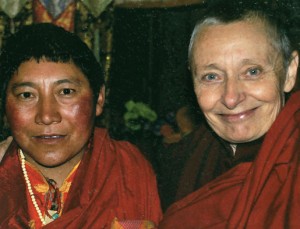
Karchug with Jetsunma Tenzin Palmo in 2007. Photo: Karen Harris.
I have lived at Gebchak Nunnery for 25 years. I was 14 years old when I first came here, and besides me there were only about 12 other new nuns here at that time. The previous Ngagsam Tulku was here then. Now his reincarnation is at Khenpo Jigme Phuntsok’s monastery, and he must be 16 or 17 years old. Lama Lodro Wangchuk, Lama Tencho, and Achen were also here at Gebchak when I first came.
…
Last year, for five days before Wangdrak Rinpoche came to the Nunnery I could see the protectors and local deities were all preparing for his arrival, and I knew that he would be coming soon. Also last year, while Wangdrak Rinpoche was giving a teaching to the nuns on Tsang-Yang Gyamtso’s commentary of the Bodhisattvacharyavatara there was an enormous parasol floating over Rinpoche’s throne, and all of the nuns listening to the teachings were adorned with white silk katas. It was marvelous, but the other nuns couldn’t see this. Outside the main entrance of the temple the two smoke-offering vessels were overflowing with white yogurt.
Usually there is a Mani drubchen[1] every year. Last year’s was exceptional. The giant torma[2] offering melted like butter in to the skull cup below it, and I could hear the Hayagriva[3] torma was neighing.
This year for ten days before Wangdrak Rinpoche came the protectors and local deities were preparing for his arrival with even more elaborate displays. There were three rows of deities forming a circular parade in the sky and the whole Nunnery was resting on a giant lotus throne. All around it were victory banners and the Eight Auspicious Symbols, and it appeared more resplendent and luminous than usual – like Zangdog Palri[4] itself.
At another time when the nuns were all gathered in the temple Tsoknyi Rinpoche, Tsang-Yang Gyamtso Rinpoche and Wangdrak Rinpoche all appeared on elevated thrones, although they were actually in Nepal and other places. They explained that they were not able to come in body because they had to be elsewhere. And they declared Gebchak Nunnery to be an extraordinary, wondrous place of great blessings. I saw all of the nuns chanting the feast offering songs and offering music to the lamas, and the temple appeared more majestic and vivid than usual.
Before any prayer ceremonies that we have in the temple, the protectors and other deities have performed them a day or so in advance of us. This happened before the Yeshe Tsogyal prayer ceremony that we recently did. During all the drubchens and ritual ceremonies that we have the deities, dakas and dakinis, and protectors are all present in the temple, and the main yidam[5] of our practice in front of the mandala.
This year, more than ever before, I have seen many amazing signs and occurrences. Tsering Che-nga [the Five Sisters of Long Life; female protectors] appeared, and during our Om Mani Padme Hum accumulation retreat the great compassionate bodhisattva was clearly present in the temple, along with so many buddhas and bodhisattvas – I couldn’t count them. The same thing happened during our Vajrakilaya drubchen. No thangka painter on earth, no matter how talented, could paint how magnificent all these deities appeared.
There is no Zangdog Palriother than this very Nunnery. As far as I see it, aside from Gecbhak Nunnery and the way of life here, there is no other way to some separately existing Zangdog Palri. Tsang-Yang Gyamtso said that Gebchak Nunnery is the second Zangdog Palri – the heavenly one is in the Akanishta pure realm, and the earthly one is here.
In my visions I’m able to see what fortune or misfortune lies ahead for the Nunnery. If I see obstacles approaching for people, I let them know what rituals and practices to do in order to avoid them.
I don’t want to be anywhere else but here, spending my time practicing these unique teachings. I made a promise to the previous Ngagsam Rinpoche, before he passed away, that I will spend my entire life practicing here at Gebchak Nunnery. To me this is a pure land.
…
[1] drubchen: a “great accomplishment practice” where a particular sadhana practice is undertaken by a group of people. It goes on uninterruptedly for seven or more days. “Mani drubchen” would be a great prayer ceremony of accomplishing the practice of Chenrezig.
[2] torma: sacrificial sculptured cakes made according to the type of deity to which they are addressed.
[3] Hayagriva: the Horse-headed One; the wrathful aspect of Amitabha.
[4] Zangdog Palri: the Glorious Copper-colored Mountain which is the pure land of Guru Rinpoche.
[5] yidam: personal meditation deity.
Note: Interview conducted in July, 2006, at Gebchak Gonpa, and translated by Tenzin Chozom.
- Read next interview.>>
- Back to Gebchak nuns.
